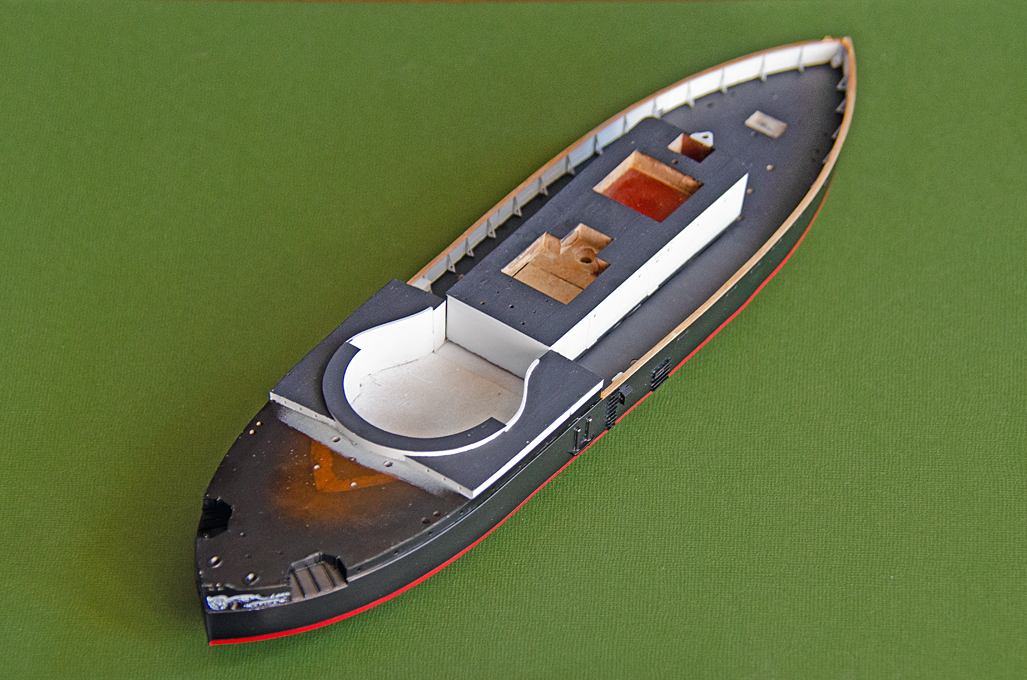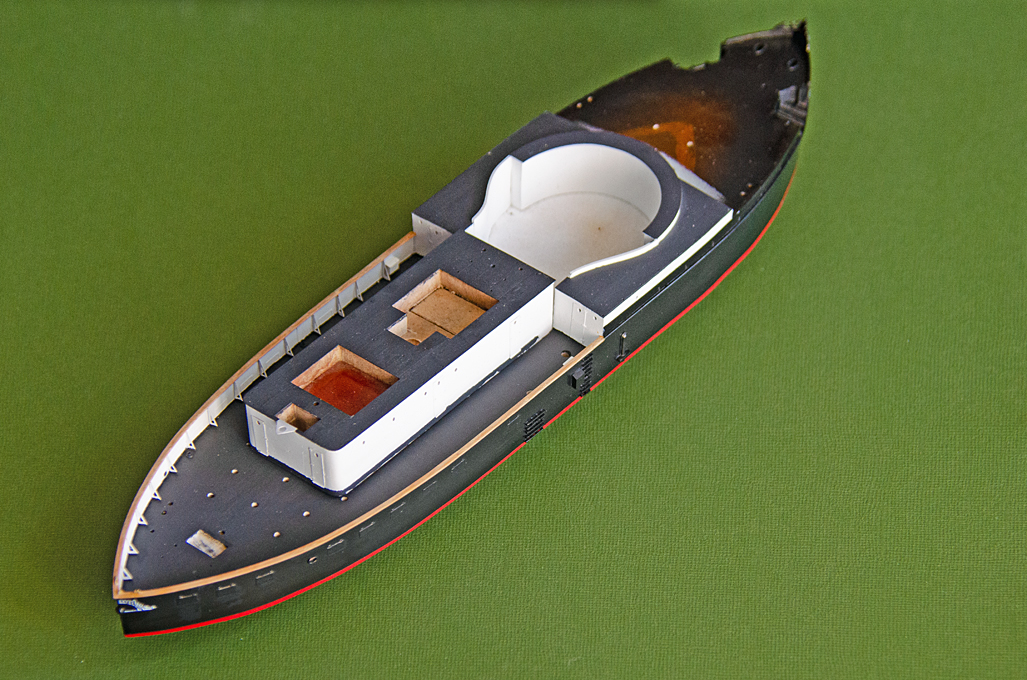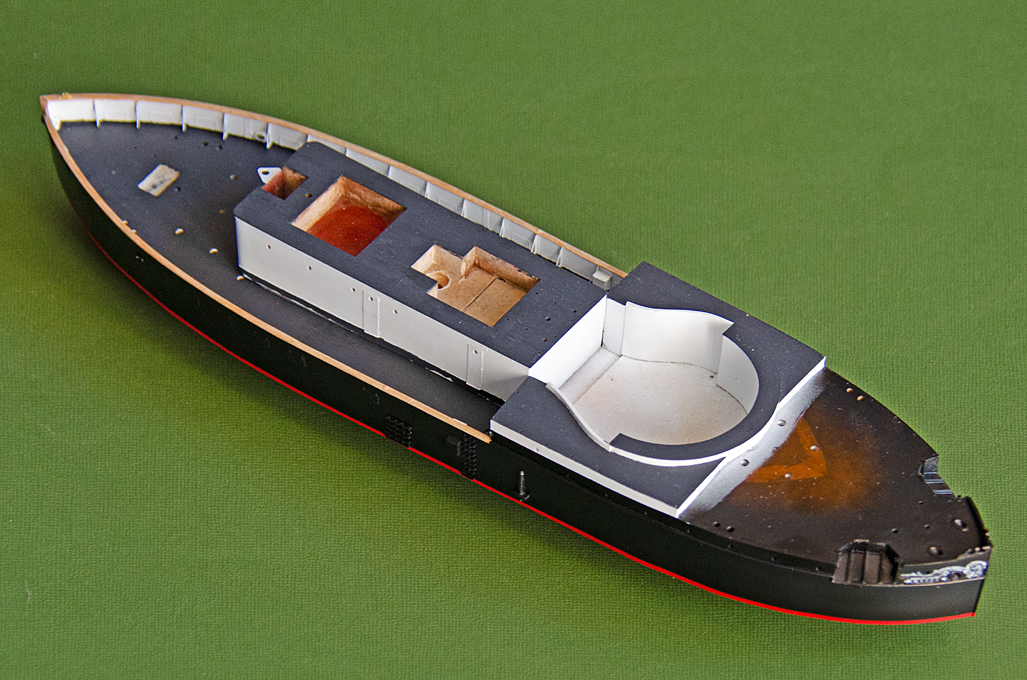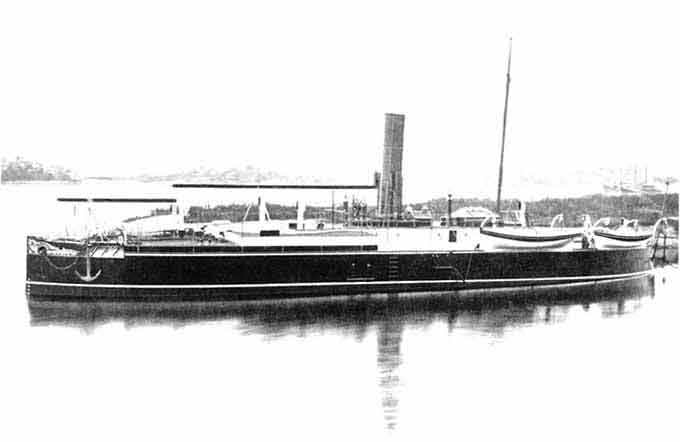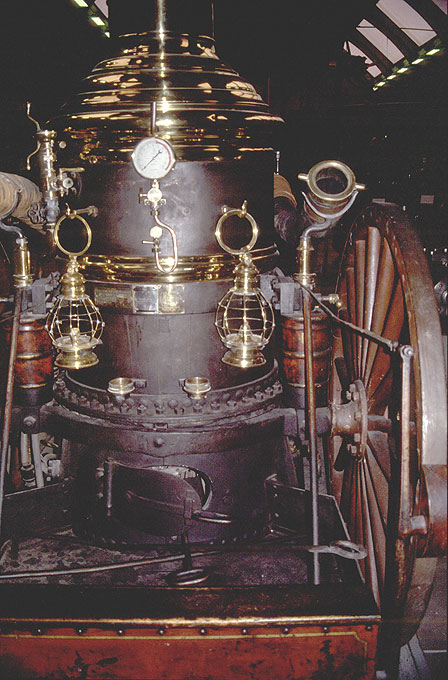-
Posts
6,543 -
Joined
-
Last visited
Content Type
Profiles
Forums
Gallery
Events
Everything posted by wefalck
-
Be aware that pastels probably will need to be 'fixed' with a very light coat of clear varnish. However, this can change the appearance of the pastels somewhat, they will look less 'dusty' but more solid - after all you just add a binder in situ to pigment that is now already there. The advantage of the pastels is that the effect can be build up gradually.
-
Yep, I was about to make the same comment on the tires and the inside of the flanges should also be bright, as the wheel touches there the rail all the time. Whether the rim would be painted or not, would depend on the livery of the company. Another thing I wondered about, when I saw you folding all those etched brass parts: you always fold them with the etched groove to the outside of the bend. Is this per instruction ? I would have thought it should be the other way round - the etched groove allows to make sharp corners. An interesting and unsual subject in any case. Some of the coaches of the Orient Express have been preserved and restored and are now operated by a company based in the Czech Republic. Some years ago I was invited to a 'dinner-cruise' out of Vienna in one of the dining cars. Some of cars are fitted out in Art Noveau (pre WW1) decoration, while others are furnished in Art Deco (post WW1) style.
-
It would be interesting to see, where the Osprey-author got his wisdom from. Was there any reference given ? From the mid 1850s own the French began to modernise old gun barrels from the 1820 to the 1850. They turned them cylindrical at the rear end and shrank steel tubes on to increase their tensile strength. They were also rifled to take projectiles that were given 'noses' to fit into the rifling. In the late 1859 they also began to experiment with breech-loading and some of the old barrels were converted into breech-loaders. This led to the Modèle 1858-60 artillery. The Modèle 1864 artillery saw newly constructed rifled breech-loaders. In 1867 they were again improved - but still no match for the Krupp breech-loaders There were a range of calibres, but they do not match excatly the numbers given above by Osprey - France had been metric since the beginning of the century. The smallest was 14 cm, then 16 cm, 19 cm, 21 cm and 23 cm (quoting from memory at the moment). As SOLFERINO was commissioned in 1861, this narrows the choice to the 1858-60 establishment. The carriages will be more complicated, as there have been many different types, depending on where they were going to be used. However, on http://www.dossiersmarine.fr/f_fco.htm it is stated that SOLFERINO only received the above armament in 1868. When first commissioned she carried apparently 36 smoothbore (?) 30-pounders and 16 50-pounders, presumably of the 1852 establishment. I have done research in the library of the Musée de la Marine and people there were generally helpsful. I have not tried 'distance' enquiries, other than telling them I would be coming around to look for this or that. This kind of research has become more complicated now, as their library and archives have been permanently moved out of Paris to a distant suburb (a not so nice area neither ...) - before, I could just hop on a bus and it dropped me right in front of the museum. My normal route is to talk to my acquaintances in the Association des Amis du Musèe de la Marine (AAMM, the association of the friends of the museum), who are very knowledgeable or can point me to someone else. However, this navy of Napoleon III is not so well researched.
-
BTW, I started looking into the naval guns, but found conflicting information on the armament of the SOLFERINO. Do you have more precise information, what she was supposed to carry at the beinning ? The data you posted earlier don't seem to be right, as far as the bores are concerned.
-
Thanks to all for their kind comments and 'tumbs-up'. @KeithAug: well, if you look really close up, you would see that it is actually not so crisp. Painting on a threedimensional surface has advantages, but also a lot of traps. In fact, on the prototype there was an angle-iron running around the edge of the deck, to which the bulwark was rivetted. I simulated the upright leg of the angle-iron by impressing rivetts into some self-adhesive aluminium foil that I cut into strips and then ran around the inside of the bulwark. The edge of that was not as crisp as I had wished for, but really saw that only during the painting. I will not do this again. This upright leg was painted black/grey on the prototype, forming a sort of waterway/kicking strip. Due to the thickness of the material it is not so easy to decide where the separation between the colours should be and paint has the tendency to creep into corners. It required touching up in both ways, the grey as well as the white, until I had a reasonably clean line. My hand is also not so steady. But I have the model mounted on a foot on which I can incline it to near vertical, which makes access easier. I used a flat hair brush to approach the kicking-strip - and was holding my breath ...
-
Thanks (belatedly) for the kind comments above and the thumbs-up ! ******************** Some post-summer progress It is quite amazing, how time passes – more than three months since the last up-date ! OK, I have been in sort of semi-vacation for six weeks in Spain, but then money-earning work seriously got into my way. Normally, I leave painting as much as possible to the very end, just before the assembly stage. This avoids damage to the paintwork by handling the model or the problem of removing dust from it. However, I felt that the project had progressed to a point, where I wanted to see how everything comes together. This also boosts the motivation, rather getting lost in fabricating endlessly little pieces. So, the model was given a good cleaning to remove dust, grease etc. The sequence of colours had to be carefully considered in order to work from the light ones to the dark ones. I also wanted to work inside out, because in this way masking was facilitated. Photograph of 1876 showing quite clearly the livery of SMS WESPE at the time. The whole paint-work is done with acrylics from Vallejo (marketed here in France under the brand ‘Prince August’) and Schmincke (a German manufacturer). Hence, I started with the white of the inside of the casemate, the bulwark and the walls of the deckhouse, which was spray-painted with the airbrush. Unfortunately, I had some trouble with the airbrush that had not been used for a while. Apparently, some paint had accumulated in the nozzle from insufficient cleaning over time. This particularly affected the white, which seems to have comparatively bigger pigment particles and is more difficult to spray anyway. Due to the various bits and pieces added to the bulwark etc., it is virtually impossible to rub down the paint and begin afresh … so the white paintwork is not as good as I had hoped for … The decks were not originally laid in wood (with the exception of the quarter deck and the floor of the casemate) or covered in linoleum at that time. They appear to have been painted with a mixture of tar and black oil-paint, with sand mixed into to provide a non-slip surface. I assumed that this mixture would attain a dark greyish colour with time due to weathering, similar to older tarmac. Prince August 996 (German ‘Panzergrau’ - tank-grey) seemed to be a suitable choice. All the deck areas were sprayed white together with the other parts to give a better key for hand-brushing. I began with painting the kicking-strips and water-ways between the bulwark stanchions and then progressed to several coats on the deck areas. All this painting was done by brush, as it would have been virtually impossible to mask-off the bulwark. The paint-schemes of the Prussian and then Imperial German Navy ships are reasonably well known for the years after 1867, as the ordinances were published in official gazettes that have survived. For the first couple of service years of SMS WESPE, the 1874 ordinance paint-scheme would have been applicable. This specifies that hulls below the waterline were to be red and above black, with a white boot-topping; another white strip was to be painted below the main rails; all ginger-bread work in white as well as all superstructures and deck-houses, ventilators, etc. Funnels and masts were to be painted yellow (buff). Photographic evidence indicates that there were some variations to this scheme for SMS WESPE, but I will discuss these, when I come to describe the painting of respective parts. First, the narrow visible part of the underwater hull was painted in Vallejo 71.269 (red RAL 3000). This area was then masked off with Tamiya masking tape. The inside of the hull was also masked and the hull sprayed black. The bulwark-rail appears to have been varnished wood. It was first given a coat of Prince August 77 (bois-wood), followed by a light wash of 834 (bois transparent), which has a slightly lighter tone, followed by another light wash of Vallejo 71.074 (beige). Finally, a very light wash of Vallejo (transparent orange) was applied, which gives the wood a deep, warm tint. The images above show the ‘raw’ paintwork. It still needs to be touched up and items such as the scrollwork needs to be refined. Eventually, there will be also a light weathering and ‘griming’ with pastels – the idea is to just show the effects of being in use, but with good maintenance. To be continued ....
-
Well, the distance between steps on stairs and ladder is pretty much uniform all over the world and all times: go to your staircase and measure the distance in Millimeters and divide that number by 64. My textbook on ship's joinery tells me that steps are around 200 mm high and about 220 mm deep, which roughly translates in 3 mm height at 1/64 scale and 3.5 mm deep.
-
Many coastal fortresses were armed with mortars in order to fire plunging shots/shells at approaching ships. While originally the idea was that the shot would penetrate to the ship's bottom and create a leak that would virtually impossible to stop, when armoured ships appeared the idea to be able to penetrate the unarmoured or only lightly armoured decks with shells to cause damage within the ship became more important. To this end in peace-time the waters around the forts would be carefully surveyed and maps drawn. With the aid of two or three observation posts the position of the ship relative to the mortar implacement would be determined by cross-sighting and the gun layed appropriately. The necessary settings would have been determined experimentally in advance.
-
The steam-pumpers would normally short sections of suction-hose, which are quite stiff, on racks alongside the chassis or another convenient place. There would be also one length of pressure hose per nozzle. Most of the pressure-hoses would be carried on a reel on a two-wheeled trailer towed behind the pumper and/or on separate carriage that would also carry some short lean-/hook-on ladders. In addition, there would be a coal- and perhaps a water-cart to provide clean boiler feed-water. The whole train may be completed by a big extendable ladder on a turn-table on a separate carriage.
-
It is really coming together nicely. There would be two types of hoses: suction hoses and pressure hoses. Suction hoses were made from rubberised canvas and were kept open (round) internally by a spiral of bronze (I guess so, as stainless steel was not available yet at that time). The suction hose is used to take water from surface water courses - at that time in most places there was no water-mains to supply hydrants. In 1:72 scale I imitated the look by winding thin copper wire around a soldering wire of suitable diameter and painting the whole thing. In your scale you might try to find a suitable spring or make one and slip it into a heat-shrink tube. The tube than can be shrunk cautiously onto the spiral, coiled and then painted. Pressure hoses also would be made from rubberised canvas, but would be flat, when not in use. In this way more length can be store on a reel. Fire-station usually have a tower in which these hoses are hanged freely to dry. They are then powdered inside with talcum to prevent the rubber from sticking together. The woven shoelace might be indeed a good representation of such pressure hose, when not in use,
-
Just checked on the Internet. This kit seems to have been modelled after one of Chapman's drawings. So it would be indeed mid- to late-1700s. During this period and even more so in the Baltic virtually all substantial parts on a ship('s deck) would have been made from wood and preserved with wood tar ('Stockholm tar'), giving it a light brownish colour. Iron work (no steel !) would be only some forged iron bands, rings, etc. Although iron has been mined in Sweden for centuries, it was still comparatively expensive due to not very efficient mining methods and high cost of fuel (charcoal) for turning the iron-ore into metal. Cast iron was still quite rare at the time and mainly restricted to high-value parts, such as guns. In the case of the kit, these metal parts, bitts for instance, then should be painted in a light wood colour and then given washes with say burnt umber in order to simulate the Stockholm tar preservation.
-
I am using razor-blades, the ones with a reenforced back. And I am using them as they come. Seems to leave smooth, flat surfaces.
-
We had this discussion at a different place already not too long ago: different, very light-weight silk papers are available from art-supply houses. Very fine silk-cloth is also available as printing screen, again through suppliers for the art-trades, printers, or through ebay in fact.
-
For fine finishes, particularly after having applied sanding filler, I also use steel-wool of various grades. It gives an nice satin finish - but make sure to remove also the little steel splinters !
-
Such sails need to be shaped (mostly) during the process, not afterwards. Glueing on the bolt-ropes with either white glue or acrylic gel gives (initially) a somewhat flexible joint, so that the sails can even be furled. If the bold-rope comes loose in places, it can be easily attached again. I have been making sails like this for 30+ years.
-
I don't think the ship were actually sailing while butchering a whale. The drag from the carcasse would have been a lot of strain on the tackles with which it was worked. Apart from the fact that in the course of the 19th century labour became increasingly expensive and, therefore, crews had to be reduced and the sail plan of vessels adapated to this, one has to keep in mind that a whaler would have to be managed by a very much reduced crew while the whaleboats were out hunting. Not sure, whether there are any statistics, but I would assume that loosing a whaleboat and its crew was not uncommon - in the fight with a whale or when bad weather developed, while the boats were out. Therefore, the whaler would need to be able to be sailed with a reduced crew. As a matter of fact, a full rig does not seem to have had much advantage over a barque rig and only on certain points to the wind. On most points the square sails would blanket each other and be ineffective. This is why the last big square-riggers were almost always barques.
-
Can one see the original somewhere on the Internet ? A Google-search only turned up model pictures of other builds from this kit. I am curious as to what kind of boiler was used. There must have been some way of checking, whether enough water was in it. Once could also use test-taps at different levels - perhaps the vertical row of the four taps? These fire engines had boilers, where most of the water was in water-tubes, which ensured quick heating up, but still there is a minimum level of water that has to be kept to prevent the tubes from burning through.
-
Things are coming together nicely ! It shows how fragile and spidery the engineering designs were at that time. I gather today one would make this much more compact. The suspension system (the 'shock absorbers') is actually quite interesting and I wonder how it really worked. Somehow it looks as if it were just a stack of leather discs. Most steam-fire engines I have seen in preservation have the boiler suspended from a ring, which in turn is supended on leaf-springs above the axles. However, looking at my pictures of the one preserved in the Stockholm technical museum, it seems to have a similar arrangement of 'shock absorbers', but in wood:
-
I gather various museum have models that were submitted together with patent applications ...
About us
Modelshipworld - Advancing Ship Modeling through Research
SSL Secured
Your security is important for us so this Website is SSL-Secured
NRG Mailing Address
Nautical Research Guild
237 South Lincoln Street
Westmont IL, 60559-1917
Model Ship World ® and the MSW logo are Registered Trademarks, and belong to the Nautical Research Guild (United States Patent and Trademark Office: No. 6,929,264 & No. 6,929,274, registered Dec. 20, 2022)
Helpful Links
About the NRG
If you enjoy building ship models that are historically accurate as well as beautiful, then The Nautical Research Guild (NRG) is just right for you.
The Guild is a non-profit educational organization whose mission is to “Advance Ship Modeling Through Research”. We provide support to our members in their efforts to raise the quality of their model ships.
The Nautical Research Guild has published our world-renowned quarterly magazine, The Nautical Research Journal, since 1955. The pages of the Journal are full of articles by accomplished ship modelers who show you how they create those exquisite details on their models, and by maritime historians who show you the correct details to build. The Journal is available in both print and digital editions. Go to the NRG web site (www.thenrg.org) to download a complimentary digital copy of the Journal. The NRG also publishes plan sets, books and compilations of back issues of the Journal and the former Ships in Scale and Model Ship Builder magazines.






